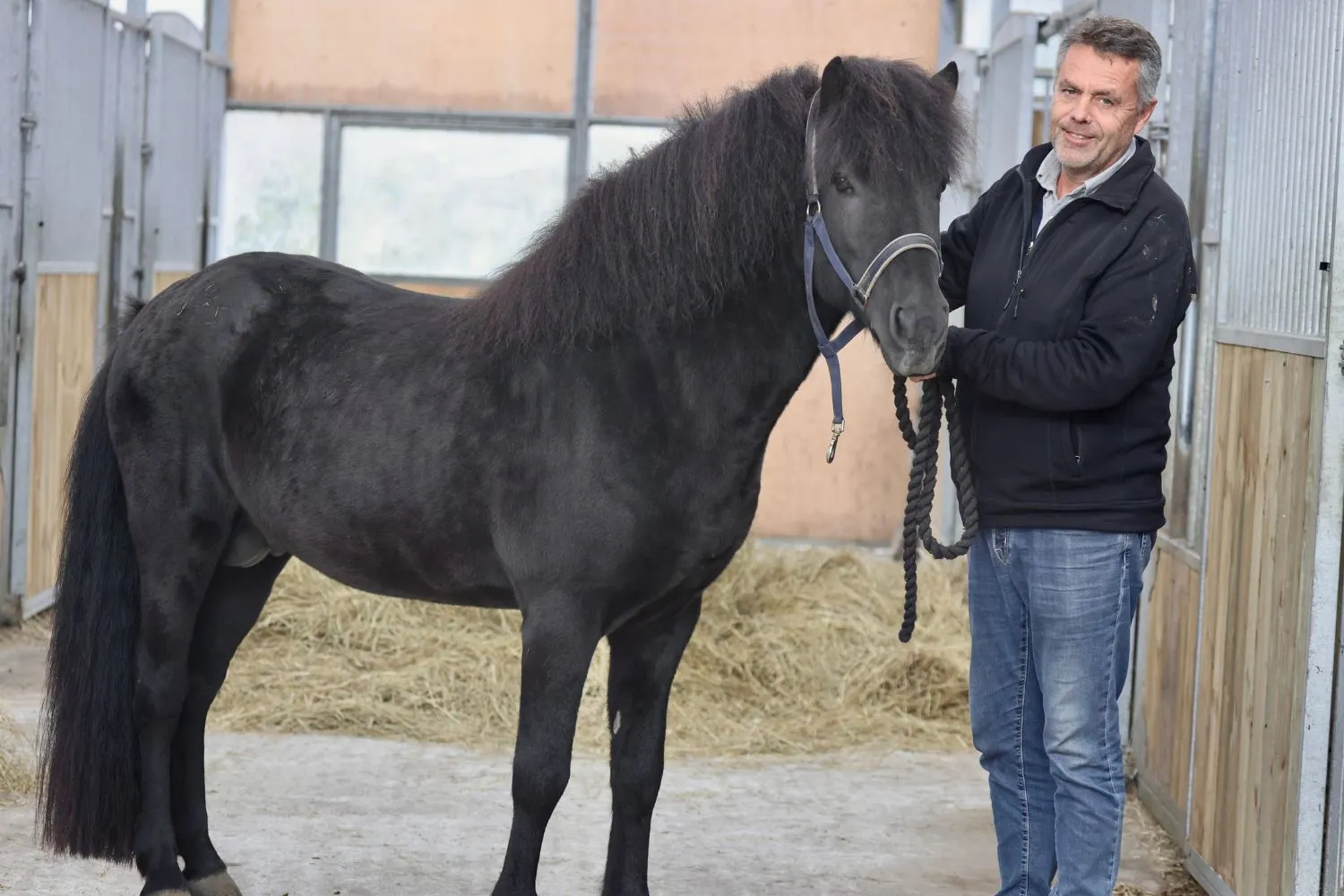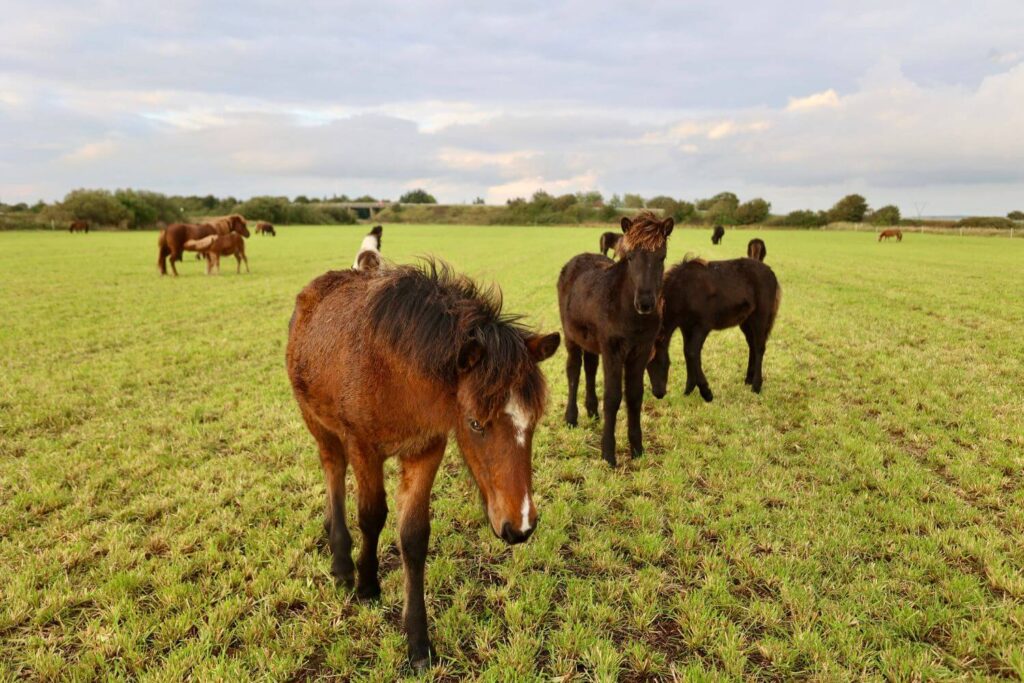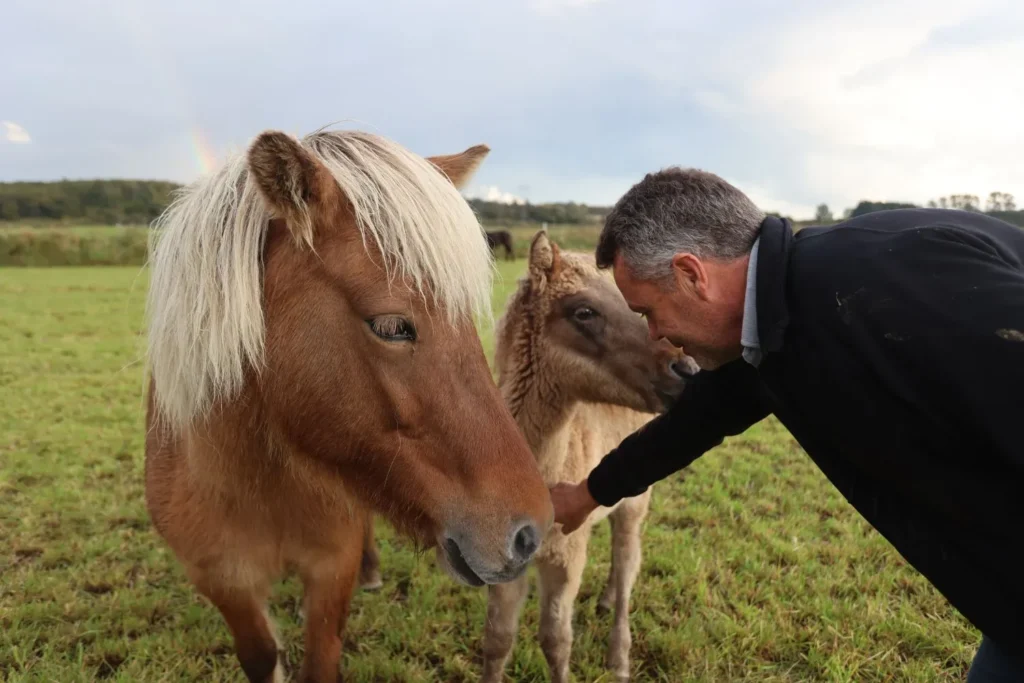Menu

Lindholm Høje Stud breeds some of the world's highest-ranked Icelandic horses. Lindholm Høje Stud has over 100 horses and some of the best breeding material within the breed. Yet there is one thing that weighs more than the horses' rankings and beautiful movements – namely a good temperament. "That's the most important thing when we choose horses for breeding," says Flemming, who runs the stud with his wife, Gitte.
High up in North Jutland, at the end of a long gravel road, lies Lindholm Høje Stud, which breeds top-quality Icelandic horses. They already have some of the highest-ranked Icelandic stallions in the world, including Kveikur from Stangarlærk, who has the world's highest blup, and Styrkur, who, according to Flemming, breeds exceptionally well and is the second most used Icelandic stallion in Denmark. Kveikur previously covered in Iceland before coming to Denmark, and four of his foals are among the best foals in all of Iceland.
To improve breeding opportunities for mare owners in Europe, the stud brought home two more of the highest-ranked Icelandic stallions from Iceland in autumn 2022. Vidar from Skör was purchased as a young stallion and has now become the world's highest-ranked stallion. In Iceland, he broke the world record with a total score of 9.04. He received 8.89 for conformation and 9.12 for riding abilities. Blakkur frá Þykkvabæ has an exceptional tölt and trot and received 9.5 for both gaits. He was one of the most sought-after breeding stallions in Iceland. "He has a good temperament, he's tall, beautiful and has long floating movements and has attracted a lot of attention."
The two stallions are well-known throughout Iceland. The news that they moved to Denmark was broadcast on national TV in Iceland. It was a definitive goodbye to Iceland, as no Icelandic horse can ever return once it has left the island. Until now, the two stallions have only been able to cover in Iceland, but from next year, many mare owners around Europe will benefit from the two newly arrived stallions. Even though both Kveikur and the new arrivals are black, colour is not a factor they focus on. A good temperament is the most important thing, followed by good conformation and riding abilities. "Our horses must always be controllable with good energy and easy to stop." During the winter, it is planned that the stallions will be trained by the stud's own rider, and if they get into really good shape, Flemming hopes that the stallions' Icelandic riders will come to Denmark and showcase them. "The rider means a lot, and the Icelandic riders are in a league of their own," Flemming explains. "They are extremely skilled and can do things differently than we can at home."
Read also: The Icelandic horse: A versatile and friendly legend
When the stud farm selects new stallions, their top priority is to find stallions with good temperaments. "We don't want crazy stallions," says Flemming with a twinkle in his eye. When choosing stallions, they must have a good temperament and be easy to work with. Flemming and Gitte place a high value on welfare, which may explain the calm behavior of the horses. Each stallion has the opportunity to fulfill its natural needs as much as possible. Each horse has its own paddock with a meter between them, so the stallions can see each other at all times. They don't close the stable doors at night, allowing the stallions to choose where they want to be. This arrangement works well when each stallion has its own free-range area where it can come and go freely throughout the day. The stallions can graze throughout the summer season, making it easier for the caretakers. There's less need for cleaning and it's better for the stallions. The front of the stall, facing the aisle, has wide bars, allowing the stallions to look down the aisle. They have access to hay and wrap ad libitum, which is also served in the aisle to make work easier and reduce waste. This results in healthy and calm horses, Flemming explains.
The stud farm has around 100 horses they breed. Mares and foals roam freely year-round on the farm's 60-hectare property. They have access to shelters with straw, as required by the horse law for outdoor horses, but the horses don't use them much.
According to Flemming, it takes a thorough understanding of the horses and their behavior to find the right combination for the herd. It's about figuring out which horses go together and not having too many horses in too small an area. They also monitor the horses to ensure they don't become overweight. Sometimes the mares are put on pastures with less grass, and in the winter, they're given wrap. The horses are fed three times a week, with wrap placed in hay racks with roofs. The mares don't receive extra feed; only the stallions or horses in training receive supplements.

Mares usually give birth in the field. The length of a mare's pregnancy varies depending on the time of year and the weather, sunlight, and grass, Flemming explains. They had one mare impregnated on September 9th. She gave birth on July 18th the following year, so her pregnancy lasted only 10 months and 9 days. Conversely, mares impregnated in April can easily have pregnancies exceeding 12 months. Sometimes mares switch foals. Flemming told a story about a breeder in Iceland who couldn't understand how one mare had a palomino foal while another had a black one. A DNA test confirmed that the mares had switched foals at birth, but they cared for the foals as if they were their own.
The stud farm only keeps the first filly and colt foal from each of their best mares. All other foals are sold, so some buyers make a good deal. A high-quality foal costs 15,000 Euros, and if it has a slightly lower Blup, it costs 12,000 Euros. Many buyers purchase foals for sport and evaluation. The stud farm doesn't offer discounts for evaluated mares since all mares advance their breeding by using one of the farm's stallions.
The foals stay with their dams and other foals in a herd until they are around 8 months old. Flemming doesn't rush the weaning process, believing that 6 months is too early. In principle, the foals could stay with their dams until the mares give birth again, at which point the mares would naturally wean the foals themselves. Often, new owners prefer to take the foals home, so the stud farm begins the weaning process around December. They wean 10 foals at a time, keeping them together in a large stable for about a week. It usually only takes a few days for the foals to adjust to their new lives. After that, basic training begins. The foals are handled every day, learning to be led and have their legs lifted. They get accustomed to new sounds and surroundings. Sometimes they are taken on a trailer or exposed to an ATV to provide them with new experiences. The foals are sold continuously, some even before they are born, and many of the foals expected next year have already been sold in advance.

Lindholm Høje Stud not only has the best stallions, but they are also at the forefront of artificial insemination and embryo transfer. Within the Icelandic horse world, embryo transfer and artificial insemination have not been used previously. However, the arrival of CEM, which affected a significant number of mares, has changed this. None of the stud farm's stallions perform natural coverings anymore, in order to minimize the risk of infection. Flemming believes that the Icelandic horse world will increasingly adopt artificial insemination, just like many other breeding associations. The process is simpler, and the pregnancy rate is nearly as high. They can send semen all over Europe, and next year there will be even more frozen semen available. Flemming has learned that Iceland is currently investigating the possibility of exporting frozen semen from stallions in Iceland. Until that becomes a reality, the two new stallions, Vidar and Blakkur, will expand the options for mare owners in Europe and the rest of the world who want a breeding with some of the highest-ranked stallions in Denmark.
Read also: Help your Icelandic horse to a summer without eczema
The stud farm has also produced embryo foals. This is a procedure where the mare is fertilized, and a few days later, the fertilized embryo is flushed out and implanted in a surrogate mare. Some buyers bring their own surrogate mare and have an embryo implanted to improve their breeding stock. Once the mare is three months pregnant, she is returned to the owner. The buyer gets a high-quality foal and, at the same time, a good riding horse. Flemming explains that only a limited number of embryos can be taken from Icelandic mares. Unlike warmblood and thoroughbred horses, where an unlimited number of embryos can be taken, only two embryos can be taken from an Icelandic mare per year, in addition to the mare's own foal. This means the procedure is less taxing for the mare.
The stud farm receives inquiries from all over Europe for semen from their stallions. During the breeding season, there are almost daily semen transports on a fixed route. During this time, the stallion stable is completely closed to outside visitors to minimize the risk of infection, as the stud farm is an approved stallion station, and the district veterinarian supervises the facility. Mares can be inseminated at home by a veterinarian, but the stud farm also offers the option of boarding the mares at Lindholm Høje. They have had 70-80 mares for insemination over the summer. Unfortunately, some mares had to be sent home without a successful insemination, as approximately 10% do not become pregnant. Kveikur had 170 pregnant mares last year and around 150 this year. The bookings come primarily from Norway and Sweden but also from all over Europe and occasionally from the United States and Australia.
There are about 3,000 Icelandic horses in Australia, and soon they will have a couple more. One of the stud farm's best horses, Fanny frá Auðsholtshjáleigu, a first-class mare with an impressive rating, is pregnant with Kveikur's foal and will soon begin her quarantine before flying to Australia. The summer season starts in September/October in Australia, so it will be an adjustment for Fanny when she arrives with her full winter coat, Flemming says. The stud farm has also sent frozen semen to Australia, and last year they successfully impregnated four mares with Kveikur.
The horses are not insured, as it would be too expensive to insure them all. With so many horses, the stud farm is essentially self-insured, but if someone only has a few horses, Flemming would 100% recommend insuring them. Fortunately, things have gone well, and the stud farm has not experienced any major injuries. They have had one horse caught in a fence and another that was kicked, but the injuries were not serious and were treated. Other than that, they have had almost no need for a veterinarian for their horses.
Although the horses are kept outdoors around the clock, it is still a lot of work to take care of them all. The stud farm employs a trainer who is trained in Iceland and, in addition, employs three staff members. Many places rely on volunteer labor, and it is easy to find people who will work for free for a few months, Flemming says. However, Flemming and Gitte have chosen not to take advantage of free labor but instead employ and pay a regular wage to their helpers. There is always something to do with so many horses, and it requires someone to be there 24 hours a day. Throughout the summer, they have a full-time employee managing bookings and organizing semen transport. Keeping track of the numerous breeding contracts and answering inquiries from interested mare owners is a big job.
If you want your mare bred with one of the highly sought-after stallions, remember to book well in advance, Flemming advises. Last summer, many people called on the day they needed semen, only to be disappointed. He explains that without a contract, mare owners cannot get a breeding because the stallion was fully booked. This is not something they are used to in Denmark, he believes.
Each of the four stallions has its own unique qualities, opening up new possibilities within breeding, Flemming concludes from Lindholm Høje Stud.